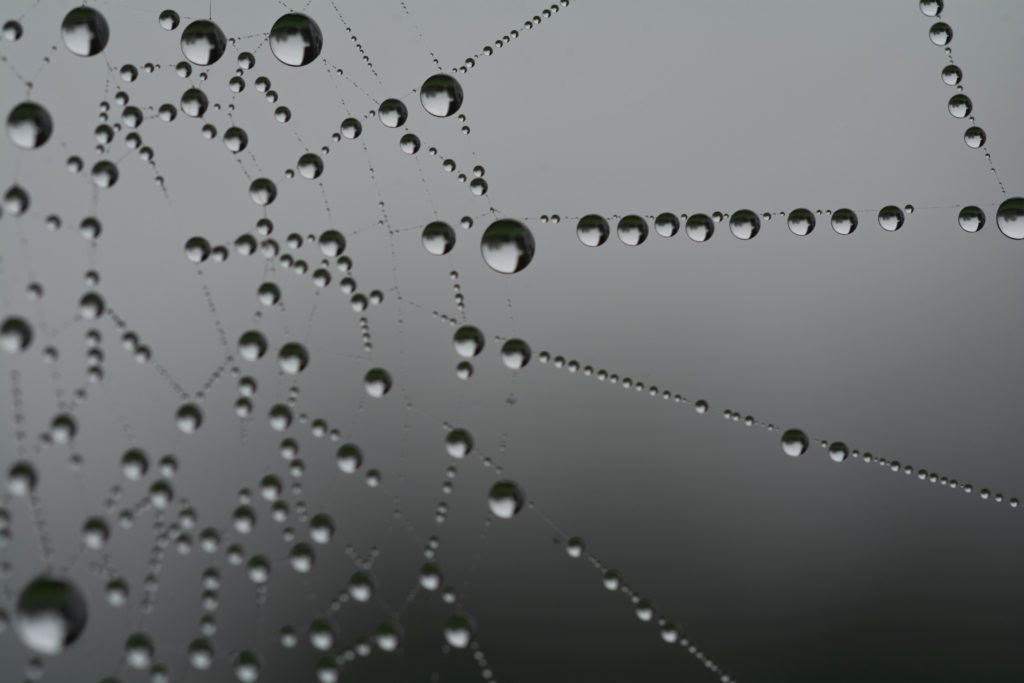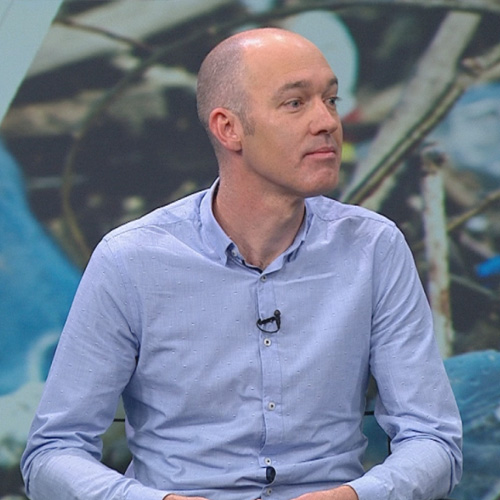
Nanoresonance Industries co-founders Athan Bloom and Dr Ekaterina Markelova are exploring how better water holds the key to many of the world’s most pressing problems including reducing the environmental footprint of the polymers industry.

As much of the world swelters and struggles with alarming heat waves and forest fires, water has taken on even greater importance. Making up more than 70% of our planet’s surface, some say that we mistakenly named our home Earth when it should have been called Planet Water, and it’s probably the liquid part of our planet that holds the answers to some of our existential challenges.
Regenerative thinkers like Daniel Christian Wahl argue that answers to our pressing needs to secure renewable sources for our material needs can be found in a shift towards biodegradable materials and particularly the use of materials that can be easily dissolved in water, allowing our industrial processes to become more aligned with our planet’s more regenerative natural systems and flows.
“We truly believe in the co-evolution of human nature and from the social perspective, this (water) is at the heart of the regenerative solutions and from the technological approach, it’s key to regenerate the water cycle,” says Dr Ekaterina Markelova, co-founder and chief sustainability officer at Nanoresonance Industries. “Water is not a renewable resource because it has lost its natural cycle. We used to know that water is a super cycle element and it regenerates its primary quality when it goes through all of the stages of its cycle through precipitation, infiltration, contact with minerals and so forth but what we see nowadays is a half cycle of water.”
Our mismanagement of the world’s water supplies present substantial challenges that need to be addressed. According to estimates, the lack of proper sanitation costs the world economy $223 billion every year and it has been estimated that every dollar spent on sanitation provides, on average, five dollars in economic return.
The accumulation of toxic herbicides and insecticides in ground and surface waters with no efficient remediation solutions is causing chemical run-offs that pollute the water systems where they generate damaging blooms of oxygen-depleting microorganisms that disrupt ecosystems and kill off aquatic life.
The use of pesticides entering our water supplies is causing a steady decline in worldwide insects due to pesticide exposure and scientists estimate that the overall decline in biodiversity to include pollinator services, “beneficial” predators, birds and aquatic life costs over $100 billion annually.
In 2009, the value of dependent crops attributed to all insect pollination was estimated to be worth $15.12 billion and overall land degradation is costing the world as much as $10.6 trillion every year, which is equivalent to 17% of global gross domestic product.
What’s more, the clear link between our water-related carbon footprint and energy use presents the climate change community with a valuable opportunity to better manage two of the world’s most valuable resources, reducing our reliance on fossil fuels.
A Deeper Understanding of Water
To address some of these pressing issues, Nanoresonance Industries and its educational arm, the Nanoresonance Institute is adopting new thinking to water by distinguishing water quality, quantity, and water state in a way that goes beyond qualitative and quantitative goals, the physical state of water, to help improve water management across all scales.
A deeper understanding of water complexity, argues Nanoresonance Industries co-founder Athan Bloom, can create greater awareness, the key to shifting science back into balance with our environment.
“I think this is a really important thing for us to understand that water is not a mineral, it’s an element. And it’s the most important and abundant element in our existence,” said Bloom in an interview with the AdaPETation Network. “Water is also a crystalline lattice matrix, capable of caring and receiving information. And so what we’ve been able to find also is that water can hold energy and the quality of that water is extremely important biologically.”
Working with his team of talented scientists, Nanoresonance Industries has discovered ways to reduce energy use and the need to use chemical cleaning products in industrial processes offering double-digit cost reductions and slashing greenhouse gas emissions for the polymers industry, amongst others.
“As far as energy, it’s extremely important,” says Bloom “Just as important it is for us to be able to hydrate properly, either as a human being or a plant or within our environment, water has other characteristics and it’s not just a solvent, but we can actually change the physical thermodynamic properties of water. For example, we can change the boiling point or the cooling point at half the typical amount of energy required so that for the industry is a tremendous amount of energy savings. This is related to cooling towers or chillers or boilers. You know, everything in industry today typically uses water. It’s not just waste water that’s a problem so we found that we could make water a better solvent, we could make water hydrate faster and using resonance and frequency, we can actually separate elements within the water at a much more efficient level than the industry is doing today. So we don’t need chemicals in a lot of these processes and this is game changing for the future of water and energy. And so what we do with technologies is we use combinations of electromagnetic resonance and frequency.”
Water and Energy Savings
The company’s technologies are already delivering impressive results in helping companies cut costs and reduce their greenhouse gas emissions, offering significant savings for almost every industry.
“With heating systems, Nanoresonance Industries has increased the heat of production by about 10% to 15%,” says Bloom, “and we are able to change the thermal capacity and increase that also by about the same about 10% 15% and water fluidity increases to about 3% to 8% so we’re able to accelerate and achieve energy savings by just treating water and understanding the purposes and the processes of the water. So we’re able to save electricity and pumping operations, reduce the amount of chemicals, which is also savings and environmental solutions where we don’t need chemicals anymore.”
Applying resonance technology to water at the nanoscale has the potential to have a far-reaching impact at a planetary scale potentially unlocking industry-wide solutions that will put the world on a more optimistic footing. Resonance has been used to clean up rivers reducing the build up of toxic algae by improving water quality at almost any scale.
“It’s not that easy to change all the industry and all the industrial activities and the cities to regenerate the full cycle of water,”says Dr Marveloka, “but what we can do at our scale is to regenerate the primary water quality by using our frequency and resonance technologies. And by doing so, we can show that the water quality can be regenerated. That is superior water quality that can be found in glaciers or the mountains. We can create this water by using our technologies and by doing so we can educate, we can dig into the problems, into solutions. So personally, I’m very optimistic. We know what to do. We know how to do it. We just need more people to cooperate. That’s it.”
The company’s ongoing research into nano resonance is part of what Dr Markelova calls “The Fifth Industrial Evolution”.
“We’re also part of this. What I would like to call, the industrial evolution, which is a co-evolution of human beings that understand that we are absolutely nature. We’re not separate from nature and with that awareness, we have a responsibility to understand how and who we are. We’re biologically tied into this great experience of life, and that we can be stewards of that if we understand how to use the same principles that nature naturally uses, and to use those at a regenerative and more sustainable way and teach this, it’s you know, I think as conscious beings, we have a responsibility. And with that responsibility actually comes a sense of pride and purpose when we empower people. But first, it takes education and an understanding of where we are in the world. And this is, I think, the excitement that we all share. And then at Resonance Industries and Resonance Institute we can create a future and a future of abundance and a smarter way that, you know, that can build a better world.”
As Bloom paints the picture. “We don’t really have a scarcity of water. We have a scarcity of innovation and change. And education is a big part of this,” he says. “Human beings are the ultimate technology. And if we realize how water works and water interrelates with our environment, we’re going to see that we have a lot more potential as human beings also than we’re led to believe and I’m with all the challenges in the world, there’s still there’s also a great need. And our goal is really to be able to help people in those needs and to help reduce poverty, to help understand that scarcity doesn’t have to be scarcity. There’s a new way. There’s other ways to do things that are in harmony with nature, such as creating sustainable technologies that we need to invest in a sustainable and regenerative future and things that benefit people. I think with the greater understanding of technologies and ourselves and our environment, I think we’re going to awaken to a new place within our purpose.”
To hear the full interview with Athan Bloom and Dr Ekaterina Markelova tune in to the AdaPETation podcast.
If you’re interested in finding out more about how you can benefit from the technologies being promoted by Nanoresonance Technologies, sign up to join the AdaPETation Network and we’ll send you more information.
Share it
Useful Links
THE HISTORY OF PLASTIC
Throughout the history of plastic, PET has been crucial in keeping food fresh with lightweight and durable packaging solutions that have helped reduce food waste for almost a century. Learn all about the invention of plastic and the important role it has played feeding people and saving the lives of humans and elephants in the adaPETation® timeline of the history of plastic.





